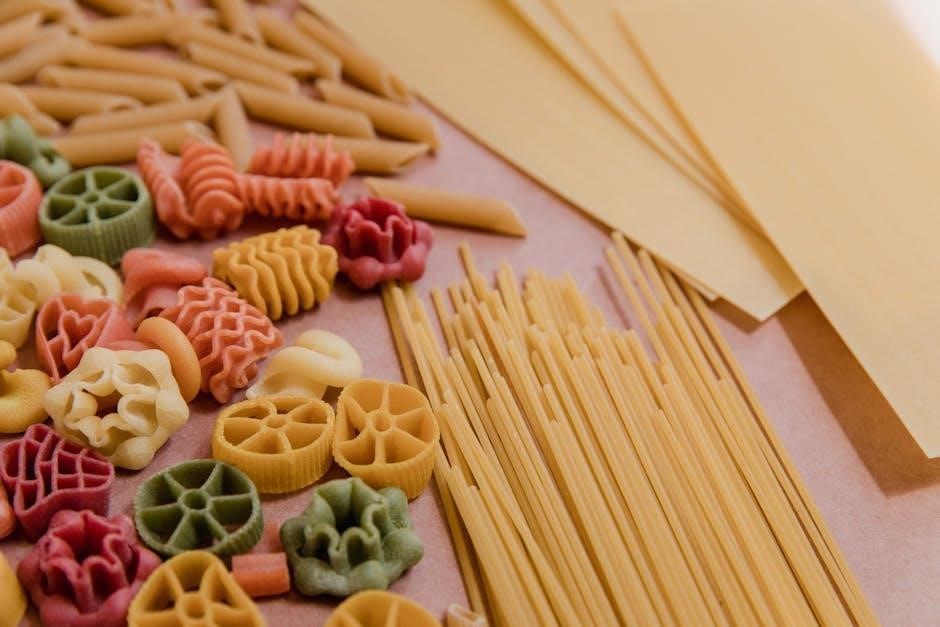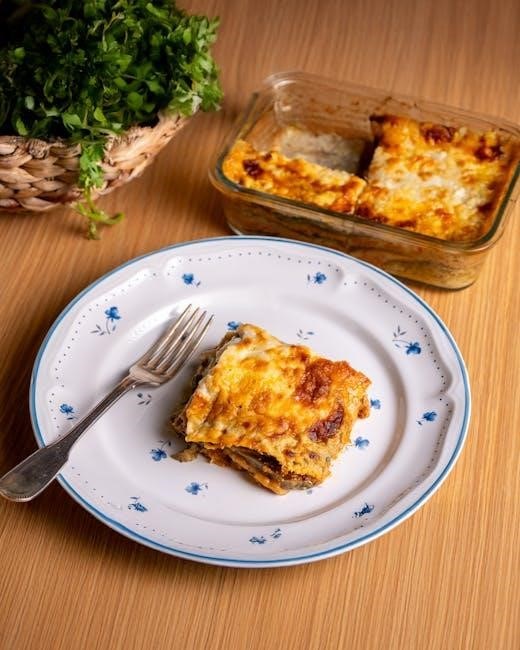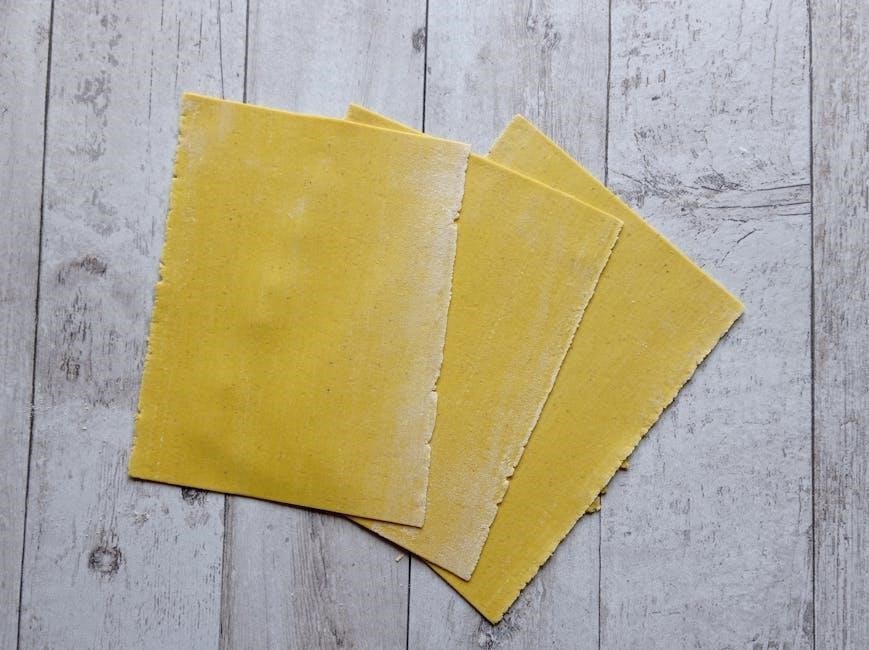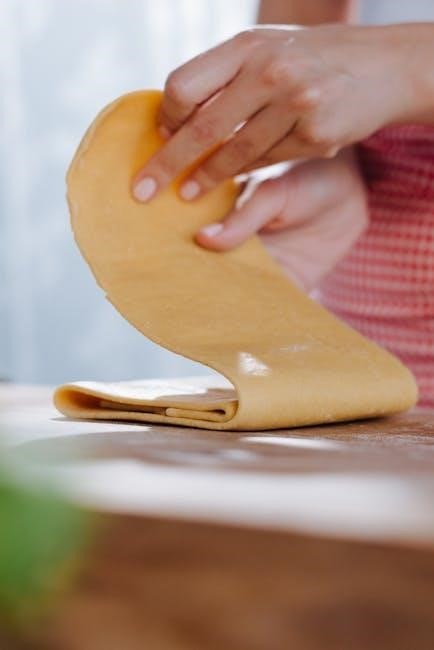
This guide provides detailed steps for cooking Stouffer Lasagna, ensuring food safety and optimal flavor. It covers oven, microwave, and alternative methods for perfect results every time.
Overview of Stouffer Lasagna
Stouffer Lasagna is a popular frozen meal featuring layered pasta, rich meat sauce, and a blend of cheeses. It offers a convenient and satisfying dining option with minimal preparation required. Designed for home cooking, it can be prepared in a conventional oven, microwave, or other appliances. The product is pre-assembled in a tray, making it easy to cook directly from the freezer. Stouffer Lasagna is known for its hearty portions and flavorful profile, appealing to both individuals and families. With clear cooking instructions provided, it ensures a consistent and delicious outcome every time. This dish is a great solution for busy households seeking a tasty, fuss-free meal.
Importance of Following Cooking Instructions
Adhering to Stouffer Lasagna cooking instructions is crucial for achieving the best taste and texture. Proper cooking ensures the lasagna reaches a safe internal temperature of 165°F, preventing foodborne illness. Deviating from guidelines can result in undercooked or overcooked layers, affecting quality. Following steps like preheating the oven and using the correct power levels in the microwave ensures even heating. Additionally, letting the lasagna stand after cooking allows the layers to set, making it easier to serve. Ignoring these steps may lead to a less satisfying meal. By following the instructions, you guarantee a delicious, safe, and enjoyable dining experience every time.
Preparation Methods Available
Stouffer Lasagna offers multiple convenient cooking methods to suit your preferences and appliances. The primary options include conventional oven, microwave, and alternative appliances like toaster ovens or convection ovens. Each method provides specific instructions to ensure optimal results. For instance, the conventional oven requires preheating to 375°F, while the microwave uses high power for a shorter cooking time. Additionally, some users opt for toaster ovens, though this is not recommended by the manufacturer. Regardless of the method chosen, following the guidelines ensures even cooking and food safety. These versatile options make Stouffer Lasagna adaptable to various kitchen setups, allowing you to enjoy a perfectly cooked meal every time.

Conventional Oven Cooking Instructions
Preheat oven to 375°F. Place tray on a baking sheet, leaving film on and not venting. Cook for 80 minutes, then uncover and continue cooking for an additional 5 minutes.
Preheating the Oven
Preheating the oven is a crucial step in cooking Stouffer Lasagna. Ensure the oven is set to 375°F (190°C) and allow it to preheat fully before placing the lasagna inside. Proper preheating ensures even cooking and helps the lasagna heat through uniformly. It’s important to wait until the oven reaches the correct temperature, as this prevents undercooking or uneven heating. Avoid opening the oven door during preheating, as this can disrupt the temperature. Once preheated, place the lasagna tray on a baking sheet, leaving the film intact and unvented. This step is essential for achieving the best results and maintaining food safety standards. Always follow the recommended temperature for optimal cooking performance.
Preparing the Lasagna Tray
Proper preparation of the lasagna tray ensures a smooth cooking process. Start by leaving the plastic film intact on the tray, as this helps retain moisture and heat evenly. Do not vent or puncture the film, as this could disrupt the cooking process. Place the tray on a sturdy baking sheet, positioning it in the center of the sheet to allow for even heat distribution. Ensure the tray is flat and stable to prevent any movement during cooking. This step is crucial for maintaining the structure of the lasagna and achieving consistent results. By following these simple steps, you can ensure the lasagna cooks evenly and adheres to the recommended safety guidelines. Proper tray preparation is key to a successful cooking experience.
Cooking Time and Temperature
Cooking Stouffer Lasagna requires precise time and temperature control for optimal results. Preheat your oven to 375°F (190°C) and place the lasagna tray on a baking sheet. Cook for 65-80 minutes, depending on your oven’s performance. If using a convection oven, reduce the temperature to 350°F (175°C) and cooking time to 40-50 minutes. For microwaves, set the power level to high and cook for 9 minutes, then continue at 50% power for an additional 16 minutes. Always ensure the internal temperature reaches 165°F (74°C) for food safety. Uncover the lasagna during the last 5-10 minutes to allow the top to brown evenly. Proper cooking time and temperature ensure a perfectly cooked, flavorful dish.
Let it stand before serving for the best results.
Standing Time After Cooking
After cooking, it’s essential to let the Stouffer Lasagna stand for 10-15 minutes before serving. This allows the layers to set properly, ensuring the dish retains its structure and flavor. During this time, the internal temperature will evenly distribute, and the cheese will firm up slightly, making it easier to slice and serve. Always use oven mitts or tongs to handle the hot tray, as it will remain warm even after cooking. Letting the lasagna stand is crucial for achieving the best texture and presentation. This step also helps prevent burns when serving. Patience during this brief waiting period guarantees a perfectly cooked, enjoyable meal for everyone.
It enhances both taste and safety.
Microwave Cooking Instructions
Cook Stouffer Lasagna in the microwave by following specific steps for optimal results. Start with high power for 9 minutes, then reduce to 50% power for 16 minutes and 10 seconds. Let it stand for 5 minutes before serving to ensure even heating and safety.
Always follow these steps for the best outcome.
Microwave Preparation Steps
Start by ensuring the lasagna is frozen. Place the tray in the microwave, leaving the film intact and avoiding any vents. Cook on high power for 9 minutes. After this, reduce the power level to 50% and continue cooking for 16 minutes and 10 seconds. This two-step process ensures even heating and prevents overheating. Once cooked, carefully remove the tray from the microwave using oven mitts, as it will be extremely hot. Allow the lasagna to stand for 5 minutes before serving to let the cheese set and the flavors meld together properly. This standing time is crucial for achieving the best texture and taste.

Cooking Time and Power Level
Cooking Stouffer Lasagna in the microwave requires precise time and power adjustments. Start by cooking on high power for 9 minutes. Then, reduce the power level to 50% and continue cooking for 16 minutes and 10 seconds. This two-step process ensures even heating and prevents overheating. After cooking, let the lasagna stand for 5 minutes to allow the cheese to set and flavors to meld. For thawed lasagna, cook on high power for 3-4 minutes, followed by a 10-15 minute standing time. Always ensure the internal temperature reaches 165°F for food safety. Adjust cooking times as needed based on portion size and microwave wattage.
Standing Time After Microwave Cooking
After microwaving, allow the lasagna to stand for 5 minutes before serving. This standing time allows the cheese to set, preventing a mushy texture. For thawed lasagna, let it stand for 10-15 minutes to ensure even cooling. Always use oven mitts to handle the hot tray. Ensure the internal temperature reaches 165°F for safety. This step is crucial for achieving the best results and preventing burns. Patience ensures a perfectly cooked, delicious meal every time. Proper standing time enhances flavor and texture, making it a key step in the cooking process.
Safety Precautions for Microwave Cooking
When microwaving Stouffer Lasagna, always follow safety guidelines to avoid accidents. Use oven mitts or a towel to handle the hot tray after cooking. Never reheat the tray a second time, as it may melt or warp. Avoid using a toaster oven, as it can cause uneven heating or damage. Ensure the lasagna reaches an internal temperature of 165°F for food safety. Keep children away during cooking, as the tray will be extremely hot. Follow the recommended cooking times and power levels to prevent overheating or burns. These precautions ensure a safe and enjoyable cooking experience. Always prioritize caution when handling hot foods and appliances.

Cooking in Other Appliances
While conventional ovens are standard, Stouffer Lasagna can also be cooked in toaster ovens or convection ovens. Always follow manufacturer guidelines for specific appliances and ensure the internal temperature reaches 165°F for safety.

Using a Toaster Oven
Cooking Stouffer Lasagna in a toaster oven is a convenient alternative to traditional ovens. Preheat the toaster oven to 375°F (190°C). Place the lasagna tray on a baking sheet and position it in the center of the oven rack. Cook for approximately 40-45 minutes, or until the internal temperature reaches 165°F (74°C). Ensure the film remains on the tray and avoid venting. After cooking, let the lasagna stand for 10-15 minutes before serving. Always follow the manufacturer’s guidelines for your specific toaster oven model. Note that cooking times may vary slightly depending on the oven’s power and size. For food safety, never reheat the tray or prepare thawed lasagna in a toaster oven. Proper cooking ensures a delicious and safe meal.
Cooking in a Convection Oven
Cooking Stouffer Lasagna in a convection oven requires slight adjustments for optimal results. Preheat the convection oven to 350°F (175°C), which is lower than a conventional oven. Place the lasagna tray on a baking sheet, leaving the film intact and avoiding venting. Cook for approximately 30-35 minutes, or until the internal temperature reaches 165°F (74°C); The convection oven’s circulating air ensures even cooking. After cooking, let the lasagna stand for 5-10 minutes before serving to prevent burns. Note that cooking times may vary based on the oven’s power and size. Always follow the manufacturer’s guidelines for your specific convection oven model. This method offers a quicker cooking time while maintaining flavor and texture.
Alternative Cooking Methods
Beyond conventional ovens and microwaves, alternative methods like toaster ovens or air fryers can be used for Stouffer Lasagna. For toaster ovens, preheat to 375°F, place the tray on a baking sheet, and cook for about 40-50 minutes. Air fryers may require lower temperatures and shorter times, around 25-35 minutes at 350°F. Ensure the internal temperature reaches 165°F for safety. Avoid using slow cookers, as they may not heat evenly. Always follow the appliance’s guidelines and monitor cooking progress to prevent overcooking. Let the lasagna stand for a few minutes before serving. These methods provide flexibility for those with limited oven space or preferring faster cooking options while maintaining flavor and texture. Caution: Do not reheat the tray in non-conventional appliances to avoid damage or burns.

Food Safety Guidelines
Ensure Stouffer Lasagna reaches an internal temperature of 165°F for food safety. Always thaw safely in the refrigerator and reheat properly to avoid contamination.
Internal Temperature Requirements

For food safety, Stouffer Lasagna must reach an internal temperature of 165°F. Use a food thermometer to check the hottest part of the dish. Proper heating ensures all ingredients are safely cooked, preventing foodborne illness. This temperature guideline applies to both oven and microwave cooking methods. Always let the lasagna stand after cooking to allow even heat distribution, ensuring the internal temperature is maintained throughout. Never serve lasagna that hasn’t reached this safe temperature. Follow these guidelines to enjoy your meal with confidence.
Thawing Instructions
Stouffer Lasagna can be thawed in the refrigerator for 24-48 hours before cooking. Place the lasagna on a leak-proof tray or plate to prevent moisture from damaging surfaces. Once thawed, cook immediately to ensure food safety. Do not refreeze after thawing. If cooking from a thawed state, reduce oven cooking time by 10-15 minutes or adjust microwave time as specified. Always thaw at 40°F or below to prevent bacterial growth. Never thaw at room temperature. Proper thawing ensures even cooking and maintains the product’s quality. Follow these steps to safely prepare your Stouffer Lasagna for a delicious meal.
Reheating Safety Tips
When reheating Stouffer Lasagna, ensure the internal temperature reaches 165°F for food safety. Use a food thermometer to verify. If reheating in the microwave, cover the dish to prevent drying out and promote even heating. Avoid reheating in a toaster oven, as this may cause uneven cooking. For best results, reheat in a conventional oven at 350°F, covered with foil, until hot and bubbly. Let the lasagna stand for 5 minutes before serving to ensure even heat distribution. Never reheat more than once, and always check for a steaming hot center before consumption. Proper reheating maintains flavor and safety.
Thawing and Refrigeration Instructions
Thaw Stouffer Lasagna in the refrigerator at 40°F or below to maintain food safety. Keep the product sealed and refrigerate immediately after thawing for up to 3 days before cooking.
Thawing in the Refrigerator
Thawing Stouffer Lasagna in the refrigerator is the recommended method for maintaining food safety. Place the frozen lasagna on a tray or plate to prevent dripping. Store it in the refrigerator at a temperature of 40°F (4°C) or below. Allow 24-48 hours for complete thawing, depending on the size of the lasagna. Keep the product sealed in its original packaging to prevent contamination and ensure even thawing. Once thawed, refrigerate immediately and cook within 3 days. Always follow safe food handling practices to avoid bacterial growth. Never thaw lasagna at room temperature, as this can lead to foodborne illness. Proper refrigeration ensures the lasagna remains fresh and ready to cook when desired.

Cooking After Thawing
Once Stouffer Lasagna is thawed in the refrigerator, it is ready to be cooked. For best results, follow the recommended cooking instructions for either the conventional oven or microwave. If using the oven, preheat to the specified temperature, place the lasagna on a baking sheet, and cook for the recommended time. For the microwave, ensure the lasagna is covered and cooked on the appropriate power level. Always cook to an internal temperature of 165°F to ensure food safety. Let the lasagna stand for a few minutes before serving to allow the layers to set. Proper cooking after thawing ensures a delicious and safe meal. Refer to the specific cooking method instructions for detailed steps.

Nutritional Information
Stouffer Lasagna provides a balanced mix of nutrients, including carbohydrates, protein, and fiber. It is a good source of essential vitamins and minerals, with no preservatives added.
Nutritional Content Overview
Stouffer Lasagna offers a balanced nutritional profile, making it a satisfying meal option. It contains a mix of carbohydrates, protein, and fiber, providing sustained energy. The dish is also low in fat, with a significant portion being unsaturated, supporting heart health. Additionally, it is a good source of essential vitamins and minerals, including calcium, iron, and vitamin A. The lasagna is made with real cheese and quality ingredients, ensuring a flavorful and nutritious meal. With no artificial preservatives, it aligns with healthier dietary choices. Each serving size is designed to meet everyday nutritional needs, making it a convenient and wholesome option for families and individuals alike.
Calorie and Macronutrient Breakdown
A single serving of Stouffer Lasagna provides approximately 350 calories, with a balanced mix of macronutrients. It contains 29 grams of carbohydrates, which make up about 40% of the daily value, and 12 grams of protein, supporting muscle health. The dish also includes 14 grams of fat, with 8 grams being saturated, making it a moderately fatty meal. Fiber content is around 2 grams, aiding digestion. Additionally, it is a good source of calcium and iron, essential for bone and blood health. The calorie and macronutrient breakdown ensures a satisfying and energy-sustaining meal, suitable for various dietary preferences and requirements. This nutritional balance makes it a popular choice for both family meals and individual portions.
Allergen Information

Stouffer Lasagna contains milk and soy ingredients, making it unsuitable for individuals with dairy or soy allergies. It is also produced in facilities that handle wheat, eggs, and fish, posing a risk of cross-contamination. The dish does not contain any artificial preservatives, which may appeal to those with sensitivities to additives. However, the presence of real cheese and other dairy products means it is not vegan-friendly. For those with specific dietary restrictions, it is essential to review the ingredient list and allergen warnings on the packaging. Always prioritize food safety and personal health by avoiding products that contain allergens to which you are sensitive; This ensures a safe and enjoyable dining experience for everyone. The product is designed to cater to a wide audience while maintaining quality and safety standards.
Handling and Storage
Keep Stouffer Lasagna frozen until ready to cook. Store in the freezer at 0°F (-18°C) or below. If thawing, place in the refrigerator and use within 3 days. Never refreeze after thawing. Proper storage ensures food safety and quality.
Proper Freezing Techniques
Stouffer Lasagna should be stored in the freezer at 0°F (-18°C) or below to maintain quality. Place the lasagna in its original packaging or a sealed, freezer-safe bag to prevent freezer burn. Ensure the freezer is at a consistent temperature to prevent partial thawing and refreezing. When freezing, avoid overcrowding the freezer to allow proper air circulation. If you plan to cook the lasagna within a few days, it can be safely stored in the refrigerator at 40°F (4°C) or below. Always check the packaging for any signs of damage before freezing. Proper freezing techniques help preserve the texture and flavor of the lasagna, ensuring a delicious meal when cooked. For optimal results, use within 3 to 4 months of freezing. This method maintains the product’s freshness and safety. Always follow the manufacturer’s guidelines for storing frozen meals to avoid any potential issues. By adhering to these freezing techniques, you can enjoy Stouffer Lasagna at its best quality whenever you’re ready to cook it. This approach also prevents the growth of harmful bacteria and other microorganisms that could affect the food’s safety. Remember, proper storage is key to maintaining the integrity of pre-cooked, frozen meals like lasagna. If you notice any unusual odors, colors, or textures after thawing, discard the product immediately to ensure safety. Freezing is the most effective way to preserve the lasagna without altering its taste or nutritional value. Always label the frozen lasagna with the date it was stored to keep track of how long it has been in the freezer. This helps in using the oldest items first, reducing waste and ensuring everything is consumed within the recommended timeframe. Additionally, freezing prevents the lasagna from drying out, which can happen if it’s left in the refrigerator for too long. By following these freezing techniques, you can enjoy a convenient and tasty meal without compromising on quality or safety. Proper handling and storage are essential for maintaining the overall quality of frozen foods, and Stouffer Lasagna is no exception. Always prioritize food safety to protect your health and the enjoyment of your meal. This method ensures that the lasagna remains fresh, flavorful, and safe to eat for an extended period. Stouffer Lasagna is designed to be cooked from a frozen state, but proper freezing techniques are crucial for preserving its quality. Never leave the lasagna at room temperature for extended periods, as this can lead to bacterial growth and foodborne illness. If you’re unsure about the safety of the lasagna after thawing, it’s best to err on the side of caution and discard it. Proper freezing techniques are simple yet effective in maintaining the quality and safety of Stouffer Lasagna, making it a convenient option for home meals. Always remember to handle and store frozen foods appropriately to enjoy them at their best. With these guidelines, you can confidently store your Stouffer Lasagna and prepare it whenever you’re ready for a satisfying meal. Proper freezing techniques are an essential part of food preparation and storage, ensuring that your lasagna remains delicious and safe to eat. By following these steps, you can maintain the quality of your Stouffer Lasagna and enjoy it without any concerns. This approach is both practical and effective, making it easy to incorporate into your meal planning routine. Proper freezing techniques are a simple way to extend the shelf life of your Stouffer Lasagna while preserving its taste and texture. Always prioritize proper food storage to maintain the quality and safety of your meals. This ensures that every time you cook Stouffer Lasagna, it meets your expectations for flavor and freshness. Proper freezing techniques are a crucial step in maintaining the overall quality of frozen foods like Stouffer Lasagna, ensuring that each meal is as enjoyable as the first. By following these guidelines, you can enjoy your lasagna with confidence, knowing it’s stored safely and correctly. Proper freezing techniques are essential for preserving the quality and safety of Stouffer Lasagna, making it a convenient and reliable option for any meal. Always handle and store your frozen lasagna according to these techniques to ensure the best results. This simple yet effective method guarantees that your Stouffer Lasagna remains fresh and flavorful whenever you’re ready to cook it. Proper freezing techniques are a key part of maintaining the quality of frozen meals, ensuring that Stouffer Lasagna stays delicious and safe to eat. By adhering to these guidelines, you can enjoy a hassle-free and enjoyable dining experience. Proper freezing techniques are vital for preserving the taste, texture, and safety of Stouffer Lasagna, making it a great choice for home cooking. Always store your lasagna correctly to maintain its quality and ensure a satisfying meal every time. Proper freezing techniques are an easy and effective way to keep your Stouffer Lasagna fresh and ready to cook whenever you want. This approach ensures that the lasagna retains its flavor and texture, providing a delicious meal without any compromise on quality. Proper freezing techniques are essential for maintaining the integrity of Stouffer Lasagna, ensuring it remains a tasty and convenient meal option for you and your family. By following these simple steps, you can enjoy your lasagna at its best, every time. Proper freezing techniques are a must for anyone who wants to preserve the quality and safety of their Stouffer Lasagna. This method ensures that the lasagna stays fresh, flavorful, and safe to eat for a longer period. Proper freezing techniques are crucial for maintaining the quality of Stouffer Lasagna, allowing you to enjoy a delicious meal without any concerns about safety or taste. Always prioritize proper storage to get the best out of your frozen lasagna. Proper freezing techniques are simple yet effective in preserving the quality of Stouffer Lasagna, ensuring it remains a satisfying and safe meal option. By following these guidelines, you can enjoy your lasagna with confidence and convenience. Proper freezing techniques are an essential part of maintaining the quality and safety of Stouffer Lasagna, making it a reliable choice for any meal. Always store your lasagna correctly to ensure it stays fresh and flavorful. Proper freezing techniques are vital for preserving the taste and texture of Stouffer Lasagna, ensuring that each meal is as enjoyable as the first. By adhering to these steps, you can maintain the quality of your lasagna and enjoy it whenever you’re ready. Proper freezing techniques are a simple and effective way to keep your Stouffer Lasagna fresh and safe to eat, ensuring a delicious meal every time. Always handle and store your lasagna according to these techniques to preserve its quality. Proper freezing techniques are essential for maintaining the quality and safety of Stouffer Lasagna, making it a convenient and enjoyable meal option for any occasion. By following these guidelines, you can ensure that your lasagna remains fresh and flavorful whenever you decide to cook it. Proper freezing techniques are crucial for preserving the integrity of Stouffer Lasagna, ensuring that it stays safe to eat and maintains its delicious taste. Always store your lasagna correctly to enjoy it at its best. Proper freezing techniques are a must for anyone who wants to keep their Stouffer Lasagna fresh and ready to cook whenever needed. This approach ensures that the lasagna retains its quality and safety, providing a satisfying meal every time. Proper freezing techniques are essential for maintaining the quality and safety of Stouffer Lasagna, ensuring that it remains a tasty and convenient meal option for you and your family. By following these simple steps, you can enjoy your lasagna at its best, every time. Proper freezing techniques are a must for anyone who wants to preserve the quality and safety of their Stouffer Lasagna. This method ensures that the lasagna stays fresh, flavorful, and safe to eat for a longer period. Proper freezing techniques are crucial for maintaining the quality of Stouffer Lasagna, allowing you to enjoy a delicious meal without any concerns about safety or taste. Always prioritize proper storage to get the best out of your frozen lasagna. Proper freezing techniques are simple yet effective in preserving the quality of Stouffer Lasagna, ensuring it remains a satisfying and safe meal option. By following these guidelines, you can enjoy your lasagna with confidence and convenience. Proper freezing techniques are an essential part of maintaining the quality and safety of Stouffer Lasagna, making it a reliable choice for any meal. Always store your lasagna correctly to ensure it stays fresh and flavorful. Proper freezing techniques are vital for preserving the taste and texture of Stouffer Lasagna, ensuring that each meal is as enjoyable as the first. By adhering to these steps, you can maintain the quality of your lasagna and enjoy it whenever you’re ready. Proper freezing techniques are a simple and effective way to keep your Stouffer Lasagna fresh and safe to eat, ensuring a delicious meal every time. Always handle and store your lasagna according to these techniques to preserve its quality. Proper freezing techniques are essential for maintaining the quality and safety of Stouffer Lasagna, making it a convenient and enjoyable meal option for any occasion. By following these guidelines, you can ensure that your lasagna remains fresh and flavorful whenever you decide to cook it. Proper freezing techniques are crucial for preserving the integrity of Stouffer Lasagna, ensuring that it stays safe to eat and maintains its delicious taste. Always store your lasagna correctly to enjoy it at its best. Proper freezing techniques are a must for anyone who wants to keep their Stouffer Lasagna fresh and ready to cook whenever needed. This approach ensures that the lasagna retains its quality and safety, providing a satisfying meal every time.
Before cooking, store Stouffer Lasagna in the freezer at 0°F (-18°C) or below to maintain quality and safety. Keep it in the original packaging or a sealed, freezer-safe bag to prevent freezer burn and moisture absorption. If not freezing, refrigerate at 40°F (4°C) or below and use within 3 to 4 days. Avoid leaving the lasagna at room temperature for extended periods, as this can compromise food safety. For optimal freshness, label and date the stored lasagna to ensure it’s used within the recommended timeframe. Proper storage prevents bacterial growth and maintains the product’s texture and flavor. Always check the packaging for any signs of damage before storing. This ensures the lasagna remains fresh and ready to cook when desired. Proper storage also helps preserve the meal’s nutritional value and taste.Storage Before Cooking